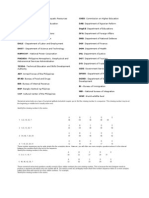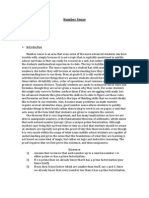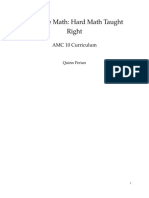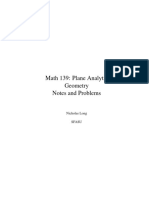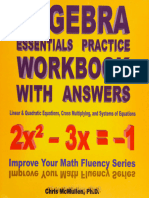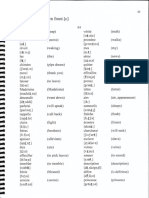ACT Math Test Tips - Pre-Algebra Review
ACT Math Test Tips - Pre-Algebra Review
Uploaded by
Mariah MoranCopyright:
Available Formats
ACT Math Test Tips - Pre-Algebra Review
ACT Math Test Tips - Pre-Algebra Review
Uploaded by
Mariah MoranOriginal Title
Copyright
Available Formats
Share this document
Did you find this document useful?
Is this content inappropriate?
Copyright:
Available Formats
ACT Math Test Tips - Pre-Algebra Review
ACT Math Test Tips - Pre-Algebra Review
Uploaded by
Mariah MoranCopyright:
Available Formats
ACT Math test – Pre-Algebra Review
Pre-Algebra
The various pre-algebra topics are the most basic on the ACT Math Test. You probably covered much
of this material in your middle school math classes. These topics are not conceptually difficult, but
they do have some nuances you may have forgotten along the way. Also, since questions covering
pre-algebra are often not that hard, you should make sure you review properly to get these questions
right.
The topics in this section appear roughly in order of frequency on the Math Test. Number problems
are usually the most common pre-algebra questions on the test, while series questions are usually the
least common.
1. Number Problems
2. Multiples, Factors, and Primes
3. Divisibility and Remainders
4. Percentages, Fractions, and Decimals
5. Ratios and Proportions
6. Mean, Median, and Mode
7. Probability
8. Absolute Value
9. Exponents and Roots
10. Series
While “Multiples, Factors, and Primes” and “Divisibility and Remainders” do not explicitly appear
too frequently on the test, the math behind them will help you answer number problems, so we’ve
included them at the top of the list.
We mentioned that the above list is only roughly ordered by decreasing frequency. If it were in an
exact order, percentages would share the top billing with number problems; because we wanted to
keep related topics close together, we sacrificed a bit of precision.
Number Problems
On the ACT Math Test, number problems are word problems that ask you to manipulate numbers.
The math in number problems is usually extremely simple. You are seldom asked to perform
operations that are more complicated than basic addition, subtraction, multiplication, and division.
Despite the simple operations, number problems can be confusing because of their wording and
because of the multiple steps involved in answering them. Here’s an example of a typical number
problem on the Math Test:
Train A travels at 90 miles per hour and covers 360 miles. Train B covers the same distance but travels
at 60 miles per hour. How much longer does it take Train B than Train A to cover that distance?
The first step in answering these questions is to read carefully to make sure you know exactly what
they are asking. Because of the time pressure of the test, some students feel as if the time they take to
understand the question is wasted since they aren’t actually doing any math. But taking a moment to
ask yourself what the question is asking is crucial. Not only will you be more likely to get the
question right if you take a moment to make sure you understand it, but that little bit of invested
time will actually save you time later, since you will be able to proceed with an understanding of
what you need to do.
Guilford County Schools Page 1
ACT Math test – Pre-Algebra Review
The question above asks the difference in time it takes the two trains to cover the same distance.
Your first step should be to figure out how long each train takes to travel 360 miles. Once you’ve
done that, you can subtract the smaller number from the bigger number to get the difference in time.
The question gives you two pieces of information that will help you figure out the trains’ times: the
speed (miles per hour) and the distance (miles). If you divide the distance by the speed, you will
cancel out the miles and end up with the hours:
Once you’ve done that, you’ll see that Train A travels for 4 hours and Train B for 6 hours:
Multiples, Factors, and Primes
Multiples, factors, and primes appear quite frequently on the ACT Math Test. You will rarely see a
non-word problem covering multiples, factors, and primes; this topic almost always appears in word
problem form.
While these questions are relatively easy, they can be quite confusing simply because of the
terminology they use. Below, we give you the definition for each of these three mathematical
concepts.
Multiples
The multiple of a number is the product generated when that number is multiplied by an integer. The
first five multiples of 7 are 7, 14, 21, 28, and 35 since and
THE LEAST COMMON MULTIPLE
The least common multiple (LCM) is the name given to the lowest multiple that two particular
numbers share. For example, the multiples of 6 and 8 are:
Multiples of 6: 6, 12, 18, 24, 30, 36, 42, 48, 54, . . .
Multiples of 8: 8, 16, 24, 32, 40, 48, 56, 64, 72, . . .
As the two lists show, 6 and 8 both have 24 and 48 as multiples (they also share many other
multiples, such as 72, 96, etc.). Because 24 is the lowest in value of these shared multiples, it is the
least common multiple of 6 and 8.
Being able to figure out the least common multiple of two numbers can prove quite handy on the
ACT, especially for questions in which you have to add or subtract two fractions with unlike
denominators (we’ll explain when we talk about fractions).
Factors
A factor of a number is an integer that divides evenly into the number. For example, 6, 4, 3, and 2 are
all factors of 12 because and Factors, then, are related to
multiples. A given number is a multiple of all of its factors: 2 and 6 are factors of 12, so 12 is a
multiple of both 2 and 6.
Guilford County Schools Page 2
ACT Math test – Pre-Algebra Review
THE GREATEST COMMON FACTOR
The greatest common factor (GCF) of two numbers is the largest factor that the two numbers share.
For example, the GCF of 18 and 24 is 6, since 6 is the largest number that is a factor of both 18 and
24.
FACTORIZATION
To find all the factors of a number, write them down in pairs, beginning with 1 and the number
you’re factoring. We’ll factor 24 for this example. So, 1 and 24 are both factors of 24. Next, try every
integer greater than 1 in increasing order. Here are the factor pairs we find for 24: 1 and 24, 2 and 12,
3 and 8, and 4 and 6.
You know you’ve found all the factors of a number when the increasing integer in each pair exceeds
the decreasing integer. For example, after you found that 4 was a factor of 24 and 5 was not, you
would see that 6, the next factor of 24, had already been included in a pair of factors. Thus, all the
factors have been found.
As you might imagine, factoring a very large number can get pretty involved. But don’t worry—that
kind of extensive factoring won’t be asked of you on the test.
Primes
A prime number is divisible by only 1 and itself (the number 1 itself is not considered prime). For
example, 17 is prime because it is divisible by only 1 and 17. The first few primes, in increasing order,
are:
2, 3, 5, 7, 11, 13, 17, 19, 23, 29, 31, 37, 41, 43, 47, 53, . . .
PRIME FACTORIZATION
Another form of factorization is called prime factorization. Prime factorization expresses an integer
as the product of a series of prime numbers.
To find the prime factorization of a number, divide it and all of its factors until every integer
remaining is prime. This group of prime numbers is the prime factorization of the original integer.
Let’s find the prime factorization of 36 as an example:
As you may already have noticed, there is more than one way to find the prime factorization of a
number. We could have first resolved 36 into for example, and then determined the prime
factorization from there. So don’t worry—you can’t screw up. No matter which path you take, you will
always get the same result—that is, as long as you do your arithmetic correctly.
Just for practice, let’s find a couple more prime factorizations:
Since the only factors of 41 are 1 and 41, it is a prime number. In other words, 41 is its own prime
factorization.
RELATIVELY PRIME NUMBERS
Two numbers are called relatively prime if they share no common prime factors (i.e., if their GCF is
1). This doesn’t necessarily mean, however, that each number is itself prime. For instance, 8 and 15
are relatively prime, because they have no common primes in their prime factorizations (
and ), but neither number is prime. It is a good idea just to know the
definition of relatively prime numbers, in case the concept pops up on the test somewhere.
Guilford County Schools Page 3
ACT Math test – Pre-Algebra Review
Divisibility and Remainders
Divisibility and remainders are also popular subjects for pre-algebraic number problems on the ACT
Math Test. As with multiples, factors, and primes, you will probably not see basic problems on
divisibility and remainders, but the topic will appear in relatively complicated word problems.
A number (x) is divisible by another number (y) if, when x is divided by y, the answer is a whole
number. For example, 6 is divisible by 3 because 6/3 = 2, and 2 is a whole number. However, 6 is not
divisible by 4, because 6/4 = 1 2/4, which is not a whole number. Another way of describing 6/4 is to
say that you can make one complete division with a remainder of 2.
To check divisibility, it is always possible to do the division by hand and see whether the result is a
whole number. However, if the number we are dividing is large, this becomes very difficult. There are
some divisibility rules that make this task much easier—these rules allow us to determine whether a
number is divisible by another number without having to carry out the division.
Divisibility Rules
1. All whole numbers are divisible by 1.
2. All numbers with a ones digit of 0, 2, 4, 6, and 8 are divisible by 2.
3. A number is divisible by 3 if its digits add up to a number divisible by 3. For example, 6,711 is
divisible by 3 because 6 + 7 + 1 + 1 = 15, and 15 is divisible by 3.
4. A number is divisible by 4 if its last two digits are divisible by 4. For example, 78,052 is
divisible by 4 because 52 is divisible by 4. But 7,850 is not divisible by 4 because 50 is not
divisible by 4.
5. A number is divisible by 5 if it ends in 0 or 5.
6. A number is divisible by 6 if it is even and also divisible by 3.
7. Sorry. There are no rules for 7.
8. A number is divisible by 8 if its last three digits are divisible by 8. For example, 905,256 is
divisible by 8 because 256 is divisible by 8. But 74,513 is not divisible by 8 because 513 is not
divisible by 8.
9. A number is divisible by 9 if its digits add up to a number divisible by 9. For example, 1,458 is
divisible by 9 because 1 + 4 + 5 + 8 = 18 and 18 is divisible by 9.
10. A number is divisible by 10 if it ends in 0.
Two Notes: (1) Because a number divided by itself always yields 1, a number is always divisible by
itself. For example, 7 is divisible by 7, and 8,374 is divisible by 8,374. (2) No number is divisible by a
number greater than itself.
Remainders
A remainder is the number that remains after x has been divided by y. If y divides evenly into x, the
remainder of is zero. A remainder will always be smaller than the number that is doing the
dividing. For instance, if you divide 22 by 5, your answer is 4 with a remainder of 2.
Percentages, Fractions, and Decimals
Percentage problems appear frequently on the ACT Math Test. Because percentages are essentially
fractions and decimals, our review of percentages will begin with a review of fractions and decimals.
While questions dealing specifically with fractions and decimals per se are rare on the ACT Math
Test, knowing more about them will aid your understanding of the more common questions about
percentages.
Guilford County Schools Page 4
ACT Math test – Pre-Algebra Review
Fractions
Although you may not see a fraction problem on the Math Test (or, at most, you’ll see one or two),
you should still review your knowledge of fractions, as they form the basis for percentages, a favorite
topic of the ACT.
A fraction describes a part of a whole. The number on the bottom of the fraction is called the
denominator, and it denotes how many equal parts the whole is divided into. The number on the top
of the fraction is called the numerator, and it denotes how many of the parts we are taking. For
example, the fraction 3/4 denotes “three of four equal parts,” 3 being the numerator and 4 being the
denominator. You can also think of fractions as similar to division. In fact, 3 /4 has the same value as
The ACT may indirectly test your ability to add, subtract, multiply, and divide fractions. Questions
that deal more directly with fractions will probably test your ability to reduce and compare fractions.
ADDING AND SUBTRACTING FRACTIONS
There are two different types of fractions that you may have to add or subtract: those with the same
denominator and those with different denominators.
If fractions have the same denominator, adding them is extremely easy. All you have to do is add up
the numerators:
Subtraction works similarly. If the denominators of the fractions are equal, then you simply subtract
one numerator from the other:
If the fractions do not have equal denominators, the process is somewhat more involved. The first
step is to make the denominators the same. To set the denominators of two fractions as equal, find
the least common denominator (LCD), which is simply the Least Common Multiple of the two
denominators. For example, 18 is the LCD of 1/ 6 and 4/9, since 18 is the smallest multiple of both 6
and 9.
Setting the denominators of two fractions equal to one another is a two-step process. First, find the
LCD. Second, write each fraction as an equivalent fraction with the LCD as the new denominator,
remembering to multiply the numerator by the same multiple as the denominator. For example, if
you wanted to add 5/12 and 4/9, you would do the following:
First, find the LCD:
1. Factor the denominators: and
2. Find the LCM of the denominators:
3. The LCD is 36.
Once you’ve found the LCD, write each fraction as an equivalent fraction with the LCD as the new
denominator. Multiply the denominator of the first fraction by an integer to get the LCD. Multiply
the numerator by the same integer.
The new first fraction is, therefore, 15/36.
Multiply the denominator and numerator of the second fraction by an integer to get the LCD.
Multiply the numerator by the same integer.
Guilford County Schools Page 5
ACT Math test – Pre-Algebra Review
The new second fraction is, therefore, 16/36.
Now that the fractions have the same denominator, you can quickly add the numerators to get the
final answer: 15 + 16 = 31, so the answer is 31 /36.
MULTIPLYING FRACTIONS
Multiplying fractions is quite easy. Simply multiply the numerators together and multiply the
denominators together, as seen in the example below:
DIVIDING FRACTIONS
Multiplication and division are inverse operations. It makes sense, then, that to perform division
with fractions, all you have to do is invert (flip over) the dividing fraction and then multiply:
Note that just as multiplication by a fraction smaller than one results in a smaller product, division
by a fraction smaller than one results in a larger product.
REDUCING FRACTIONS
If you encounter fractions involving large, unwieldy numbers, such as 18/ 102, the best move is usually
to see if the fraction can be reduced to smaller numbers.
The fastest way to simplify a fraction is to divide both the numerator and denominator by their
greatest common factor. In the case of 18/ 102, the GCF of 18 and 102 is 6, leaving you with 3/ 17. With
your knowledge of divisibility rules, you should be able to see that both the numerator and
denominator are divisible by 6. Had you not immediately seen that 6 was the greatest common
factor, you could have divided both numbers by 2 and gotten 9/51. From there, it would have been
pretty obvious that both the numerator and denominator are also divisible by 3, yielding 3/17.
The ACT might also present you with variables in fraction form and ask you to reduce them. You can
reduce these variable fractions as long as you can find like factors in both the numerator and
denominator. For example, to reduce this fraction,
you merely have to notice that all of the terms in both the numerator and denominator contain 2 as a
factor. Dividing 2 out of the fraction, you get:
COMPARING FRACTIONS
The rare fraction problem you see may ask you to compare two fractions. If either the denominators
or the numerators of the two fractions are the same, that comparison is easy. For example, 8/9 is
obviously greater than 5 /9, just as 5/9 is greater than 5/ 17. Just remember, if the numerators are the
same, the greater fraction is the one with the smaller denominator.
If the two fractions don’t lend themselves to easy comparison, there is still a quick and easy method
that will allow you to make the comparison: cross multiplication. To do this, multiply the numerator
Guilford County Schools Page 6
ACT Math test – Pre-Algebra Review
of each fraction by the denominator of the other. Write the product of each multiplication next to the
numerator you used to calculate it. The greater product will be next to the greater fraction. For
example:
Since 35, the greater product, is written next to 5/8, that is the greater fraction.
Decimals
Decimals are simply another way to express fractions. To get a decimal, divide the numerator of a
fraction by the denominator. For example, if you take the fraction 2 /5 and divide 2 by 5, you get 0.4.
Therefore the decimal 0.4 is equal to 2/ 5.
Questions testing decimals almost never appear on the ACT. If decimal numbers do appear and you
have to add, subtract, multiply, or divide them, the best thing to do is to use a calculator.
Percentages
Percentage problems always make an appearance on the ACT Math Test. You will probably see at
least two per test. Percentages are just another way to talk about a specific type of fraction. Percent
literally means “of 100.” If you have 25% of all the money in the world, that means you have 25/100 of
the world’s money.
Let’s take the question “4 is what percent of 20?” This question presents you with a whole, 20, and
then asks you to determine how much of that whole 4 represents in percentage form, which means
“of 100.” To come to the answer, you have to set up an equation that sets the fraction 4/20 equal to
x/100:
If you then cross multiply to solve for x, you get 20x = 400, meaning x = 20. Therefore, 4 is 20% of
20. You also might realize that instead of working out all this cross multiplication, you could simply
do the following:
IMPORTANT PERCENTAGE TERMS
Percentage terminology can be a little tricky, so here is a short glossary of terms:
Percent more: if one person has 50% more children than a second person, then that first
person has the same amount as the second person, plus 50% of the amount the second
person has.
Percent increase: percent increase means the same thing as percent more. If the price of
some item increases 10%, the new price is the original plus 10% of that original—in other
words, 110% of the original.
Percent decrease: the opposite of percent increase. This term means you subtract the
specified percent of the original value from that original.
Sometimes students see these terms and figure out what the 10% increase or decrease is, but then
forget to carry out the necessary addition or subtraction. Here’s a sample ACT percentage problem:
Guilford County Schools Page 7
ACT Math test – Pre-Algebra Review
A shirt originally cost $20, but during a sale its price was reduced by 15%. What is the current price of
the shirt?
A. $3
B. $5
C. $13
D. $17
E. $23
In this question, you are told the whole, $20, and the percentage, 15%, and you need to figure out the
part. You can therefore quickly set up the equation (once you are comfortable with percentages you
might be able to skip this step of setting up the equation and move straight to solving for x):
You can find x by multiplying 20 by .15 to see what the change in price was:
Once you know the price change, you then need to subtract it from the original price, since the
question asks for the reduced price of the shirt.
The answer is D. Notice that if you had only finished the first part of this solution and had looked at
the answer choices, you might have seen that $3 hanging out at answer A like a big affirmation of
correctness and been tempted into choosing it without finishing the question. You could also solve
this problem in one step by realizing that if the sale price was 15% lower than the original, it was 85%
of the original. Therefore, $0.85($20) = $17.
DOUBLE PERCENTAGES
Some ACT questions will ask you to determine a percent of a percent. Take this question:
The original price of a banana in a store is $2. During a sale, the store reduces the price by 25% and Joe
buys the banana. Joe then meets his friend, Sam, who is almost faint with hunger. Seeing an opportunity,
Joe raises the price of the banana 10% from the price at which he bought it, and sells it to Sam. How
much does Sam pay?
In this question, you are asked to determine the cumulative effect of two percentage changes. The
key to solving this type of problem is to realize that each percentage change is dependent on the last.
In other words, you have to work out the effect of the first percentage change, come up with a value,
and then use that value to determine the effect of the second percentage change.
In the problem asked above, you would first find 25% of the original price.
Now subtract that $.50 from the original price.
Then we find 10% of $1.50:
Therefore, Sam buys the banana at a price of $1.50 + $.15 = $1.65.
When you are working on a percentage problem that involves a series of percentage changes, you
should follow the same procedure you would for one single percentage change at each stage of the
series. For the first percentage change, figure out what the whole is, calculate the percentage of the
Guilford County Schools Page 8
ACT Math test – Pre-Algebra Review
whole, and make sure to perform addition or subtraction, if necessary. Then take the new value and
put it through these same steps for the second percentage change.
Ratios and Proportions
On the typical ACT Math Test, you’ll see a couple of problems dealing with proportions or ratios.
Ratios
Ratios can look a lot like fractions, and they are related to fractions, but they differ in important
ways. Whereas a fraction describes a part out of a whole, a ratio compares two separate parts of the
same whole.
A ratio can be written in a variety of ways. Mathematically it can appear as 3/1 or as 3:1. In words, it
should be written out as the ratio of three to one. Each of these three forms of this ratio means the
same thing: there are three of one thing for every one of another. If you have three red marbles and
one blue marble, then the ratio of red marbles to blue marbles is 3:1. For the ACT, you must
remember that ratios compare parts to parts, rather than parts to a whole. For example:
Of every 40 games a baseball team plays, it loses 12 games. What is the ratio of the team’s losses to
wins?
A. 3:10
B. 7:10
C. 3:7
D. 7:3
E. 10:3
This ratio question is a little tricky because the information is stated in terms of whole to part, but
the question asks for a part to part answer. The problem tells you that the team loses 12 of every 40
games, but it asks you for the ratio of losses to wins, not losses to games. So the first thing you have
to figure out is how many times the team wins in 40 games:
The team wins 28 of every 40 games. So for every 12 losses, the team has 28 wins, or 12:28. You can
reduce this ratio by dividing both sides by 4, to get 3 losses for every 7 wins, or 3:7. Answer C is
correct. However, if you didn’t realize that losses to games was part to whole, you might have just
reduced the ratio 12:40 to 3:10, and then picked choice A.
Proportions
If you have a ratio of 3 red marbles to 1 blue marble, that doesn’t necessarily mean that you have
exactly 3 red marbles and 1 blue one. It could also mean that you have 6 red and 2 blue marbles, or
that you have 240 red and 80 blue marbles. In other words, ratios compare only relative size. In
order to determine how many of each color of marbles you actually have, you need to know how
many total marbles you have in addition to knowing the ratio.
The ACT will occasionally ask questions testing your ability to figure out a quantity given the ratio
between items and the total number of all the items. For example:
You have red, blue, and green marbles in the ratio of 5:4:3, and you have a total of 36 marbles. How
many blue marbles do you have?
The information given states that for each group of 5 red marbles, you have a corresponding group of
4 blue marbles and a group of 3 green marbles. The ratio therefore tells you that out of every 12
Guilford County Schools Page 9
ACT Math test – Pre-Algebra Review
marbles (since 12 = 5 + 4 + 3), 4 of them will be blue. The question also tells you that you have 36
total marbles.
Since we know that the ratio will not change no matter how many marbles you have, we can solve
this problem by setting up a proportion, which is an equation that states that two ratios are equal. In
this case, we are going to equate 4:12 and x:36, with x being the number of blue marbles that we
would have if we had 36 total marbles. To do math with proportions, it is most useful to set up the
proportions in fraction form:
Now you just need to isolate x by cross-multiplying:
Mean, Median, and Mode
The arithmetic mean, median, and mode are all different ways to describe a group, or set, of
numbers. On the ACT, you’ll most likely see questions dealing with the arithmetic mean, but you
should be prepared for median and mode questions as well.
Arithmetic Mean (a.k.a. Average)
The arithmetic mean, which is also called the average, is the most important and most commonly
tested of these three mathematical concepts. The basic rules for finding an average are not very
complicated. To find the average of a set of n numbers, you need to find the sum of all the numbers
and divide that sum by n.
For example, the mean of the set 9, 8, 13, 10 is:
Many ACT problems about mean will be straightforward, giving you a bunch of numbers and asking
you to find their average. But some problems will be presented in a more roundabout fashion. For
instance, the ACT might give you three numbers of a four--number set as well as the average of that
set, and ask you to find the fourth number, like so:
If the average of four numbers is 22, and three of the numbers are 7, 11, and 18, then what is the fourth
number?
To solve this type of problem, you have to realize that if you know the average of a group, and also
know how many numbers are in the group, you can calculate the sum of the numbers in the group. In
the question asked above, you know that the average of the numbers is 22 and that there are four
numbers. This means that the four numbers, when added together, must equal which is 88.
Now, from the information given in the problem and our own calculations, we know three of the four
numbers in the set and the total sum of the numbers in the set:
Solving for the unknown number is easy: all you have to do is subtract 7, 11, and 18 from 88 to get 52,
which is the answer.
Guilford County Schools Page 10
ACT Math test – Pre-Algebra Review
Median
The median is the number whose value is in the middle of the numbers in a particular set. Take the
set 6, 19, 3, 11, 7. If we arrange the numbers in order of value, we get:
When we list the numbers in this way, it becomes clear that the middle number in this group is 7,
making 7 the median.
The set we just looked at contained an odd number of items, but in a set with an even number of
items it’s impossible to isolate a single number as the median. Let’s add one number to the set from
the previous example:
In this case, we find the median by taking the two numbers in the middle and finding their average.
The two middle numbers in this set are 7 and 11, so the median of the set is (7 + 11)/2 = 9.
Mode
The mode is the number within a set that appears most frequently. In the set 10, 11, 13, 11, 20, the
mode is 11 since that number appears twice and all the others appear just once. In a set where all the
numbers appear an equal number of times, there is no mode.
Probability
A typical ACT Math Test asks one question on probability. To begin to deal with these questions, you
first have to understand what probability is:
For example, let’s say you’re on a game show and are shown three doors. Behind one door there is a
prize, while behind the other two doors sit big piles of nothing. The probability that you will choose
the door with the prize is 1 /3, because out of the total three possibilities there is one chance to pick
the lucrative door.
Here’s an example of a probability question:
Joe has 3 green marbles, 2 red marbles, and 5 blue marbles. If all the marbles are dropped into a dark
bag, what is the probability that Joe will pick out a green marble?
There are three ways for Joe to pick a green marble (since there are three different green marbles),
but there are 10 total possible outcomes (one for each marble in the bag). Therefore, the probability
of picking a green marble is:
When you calculate probability, always be careful to divide by the total number of possible outcomes.
In the last example, you may have been tempted to leave out the three chances of picking a green
marble from the total possibilities, yielding the equation P = 3/7. If you did that, you’d be wrong.
Absolute Value
The absolute value of a number is its magnitude, regardless of sign. Absolute value is indicated by
two vertical lines that surround the number: |5|and |–5|, for example. The absolute value of positive
five is equal to five: |5| = 5. The absolute value of negative five is also equal to five: |–5| = 5. Simply
remove the sign before the number to produce its absolute value.
Guilford County Schools Page 11
ACT Math test – Pre-Algebra Review
On the ACT, you will generally be asked to do a simple addition, subtraction, multiplication, or
division problem using the absolute values of numbers. For example,
Remember that the vertical lines mean you simply ignore the sign, so the question actually looks like
this: 4 + 2 = 6
Exponents and Roots
At most, you’ll see one problem on the ACT Math Test dealing with exponents or roots. It’s quite
likely you won’t see any, but you’re still doing yourself a favor by preparing for them.
Exponents
Exponents are a shorthand method of describing how many times a particular number is multiplied
by itself. To write in exponent form, we would simply count how many threes were
being multiplied together (in this case, five), and then write In verbal form, is stated as “three
to the fifth power.”
RAISING AN EXPONENT TO AN EXPONENT
Occasionally, a question might ask you to raise a power to a power, in the following format: In
such cases, multiply the exponents:
If you have an expression involving a variable, like and you raise it to the third power, then you
would write To simplify this expression, you would multiply the exponents and raise 2 to the
third power; the end result would be Most basic calculators have an exponent or function key.
Be sure to know how to use this function on your calculator before the test.
Square Roots
The square root of a number is the number that, when squared (multiplied by itself), is equal to the
given number. For example, the square root of 16 is 4, because A perfect square is a
number whose square root is an integer.
The sign denoting a square root is To use the previous example, Again, be sure to find
and know how to use the square-root function, or key, on your calculator.
Cube Roots
The cube root of a number is the number that, when cubed (raised to the third power), is equal to the
given number. The cube root of 8 is 2, because
The sign denoting a cube root is
Series
Series questions are pretty rare on the ACT. Every once in a while they do pop up, though. A series is
a sequence of numbers that proceed one after another, according to some pattern. Usually the ACT
will give you a few numbers in a series and ask you to specify what number should come next.
Guilford County Schools Page 12
ACT Math test – Pre-Algebra Review
For example,
is a series in which each number is multiplied by –2 to yield the next number; 32 is the next number
in the series. This type of question asks you to be able to recognize patterns and then apply them.
There isn’t one tried-and-true way to find a pattern. Just think critically, and use your intuition and
trial and error.
http://www.sparknotes.com/testprep/books/act/chapter2.rhtml
Guilford County Schools Page 13
You might also like
- Ultimate Guide To The Math ACT - Richard CornDocument387 pagesUltimate Guide To The Math ACT - Richard Cornbekki100% (7)
- Reveiwer Sa SPES (1) NewDocument3 pagesReveiwer Sa SPES (1) NewLowie D Gaceta81% (75)
- Maths Olympiad Contest Problems: Exploring Maths Through Problem SolvingDocument10 pagesMaths Olympiad Contest Problems: Exploring Maths Through Problem Solvingnearurheart1No ratings yet
- Significant Figures PDFDocument2 pagesSignificant Figures PDFKarlzNo ratings yet
- Faculty of Computing and Informatics Multimedia UniversityDocument11 pagesFaculty of Computing and Informatics Multimedia UniversityBala GanabathyNo ratings yet
- Maths the Wacky Way for Students...By a Student: From Foundation up to Higher Level GcseFrom EverandMaths the Wacky Way for Students...By a Student: From Foundation up to Higher Level GcseNo ratings yet
- Entry Test Quick Solution Maths ShortcutsDocument91 pagesEntry Test Quick Solution Maths Shortcutsfarhan92% (48)
- Aptitude TestsDocument10 pagesAptitude TestsGilbert Gunadiish NyavieNo ratings yet
- FREE Ebook - 10 Math Topics That Appear in Civil Service ExamDocument22 pagesFREE Ebook - 10 Math Topics That Appear in Civil Service ExamGrace HernandezNo ratings yet
- STEP Crash Course Booklet PreviewDocument9 pagesSTEP Crash Course Booklet PreviewTaimur AbdaalNo ratings yet
- The Quantitative Ability Section at A GlanceDocument4 pagesThe Quantitative Ability Section at A Glanceferoz_stylist3738No ratings yet
- Basic Highway Math ManualDocument75 pagesBasic Highway Math ManualdpxNo ratings yet
- Thesis Topics in Number TheoryDocument6 pagesThesis Topics in Number Theorycarlamolinafortwayne100% (2)
- Algebraic Expression Word Problems and AnswersDocument24 pagesAlgebraic Expression Word Problems and AnswersJeselica Anne Marie CastroNo ratings yet
- Analytical Ability Review Tips and TricksDocument5 pagesAnalytical Ability Review Tips and TricksglecyrosebastawangbannoNo ratings yet
- Dan - Number SenseDocument6 pagesDan - Number Senseapi-231033473No ratings yet
- 10 Math Questions That Appear inDocument2 pages10 Math Questions That Appear inKenneth Cantil LisboNo ratings yet
- ACT Math Test Tips - Algebra ReviewDocument10 pagesACT Math Test Tips - Algebra ReviewCelestine SiamehNo ratings yet
- Example 1: Find The Least Common Multiple of 3 and 5Document3 pagesExample 1: Find The Least Common Multiple of 3 and 5AAMCNo ratings yet
- GMAT Math StrategiesDocument7 pagesGMAT Math StrategiesRubayet RonyNo ratings yet
- IBPS Data Interpretation & Maths - High Priority Areas, ShortcutsDocument8 pagesIBPS Data Interpretation & Maths - High Priority Areas, ShortcutsvalmikisatishNo ratings yet
- Determining SufficiencyDocument10 pagesDetermining SufficiencyManik KarmakarNo ratings yet
- Extension Maths 1Document108 pagesExtension Maths 1Zac Dewar100% (1)
- Numerical Reasoning Practice TestDocument15 pagesNumerical Reasoning Practice TestJundy DuyagNo ratings yet
- Number System Aptitude Test Questions - Concepts Formulas and TricksDocument7 pagesNumber System Aptitude Test Questions - Concepts Formulas and TricksdrasansamNo ratings yet
- Texes Generalistec 6 FinalDocument173 pagesTexes Generalistec 6 FinalMiguel Alejandro Flores EspinoNo ratings yet
- Compete Math - AMC10Document106 pagesCompete Math - AMC10Anonymous tE78WxCNo ratings yet
- Algebra 1Document168 pagesAlgebra 1catNo ratings yet
- Sat PDFDocument95 pagesSat PDFZaruhi ZhamharyanNo ratings yet
- Solving Equations: Word ExamplesDocument5 pagesSolving Equations: Word ExamplesWeb BooksNo ratings yet
- StrategiesDocument3 pagesStrategiesmuhammadahmedamin0No ratings yet
- ACT Math Formulas: You Should KnowDocument12 pagesACT Math Formulas: You Should KnowSweeshi 17No ratings yet
- GMAT 6 Ed Og 2016 Fom Drill Booklet 1Document13 pagesGMAT 6 Ed Og 2016 Fom Drill Booklet 1Saumya GuptaNo ratings yet
- Statistical Analysis: Arithmetic Mean (A.k.a. Average)Document11 pagesStatistical Analysis: Arithmetic Mean (A.k.a. Average)OnlineTutoring BptNo ratings yet
- Sample PDF - 1: Aptitude Tips and TricksDocument10 pagesSample PDF - 1: Aptitude Tips and TricksKarishma PotnuruNo ratings yet
- 139 Notes s16Document66 pages139 Notes s16Carl Patrick Erni RagasNo ratings yet
- New Course WorkbookDocument205 pagesNew Course WorkbookRohan SahaNo ratings yet
- Numerical Reasoning Practice TestDocument9 pagesNumerical Reasoning Practice TestJeselica Anne Marie CastroNo ratings yet
- Aptitude TestDocument4 pagesAptitude TestAnna Jean BasilioNo ratings yet
- AlgebraDocument39 pagesAlgebraDivya GersappaNo ratings yet
- The Truth of The Engineering Entrance ExamsDocument9 pagesThe Truth of The Engineering Entrance ExamsRushikesh BhagatNo ratings yet
- Welcome To The 49 United States of America Mathematical Olympiad!Document3 pagesWelcome To The 49 United States of America Mathematical Olympiad!Kamran MehdiyevNo ratings yet
- Quantitative Comparison Questions - KasandraDocument11 pagesQuantitative Comparison Questions - KasandraMonicaNo ratings yet
- NET Guide PDFDocument5 pagesNET Guide PDFmuneebNo ratings yet
- Math BootcampDocument23 pagesMath BootcampKirankumar ReddyNo ratings yet
- GCF and LCM MaterialDocument3 pagesGCF and LCM MaterialZyra Mae AntidoNo ratings yet
- Fundamentals of Data SufficiencyDocument2 pagesFundamentals of Data SufficiencykishoreNo ratings yet
- Complete Math ReviewerDocument132 pagesComplete Math ReviewerLance Malvar PasicoNo ratings yet
- CS Math ReviewerDocument84 pagesCS Math ReviewerJohn Rafael SordanNo ratings yet
- Prime Factorization Homework 3.3Document4 pagesPrime Factorization Homework 3.3ere50xvb100% (1)
- How To Get The Greatest Common Factor of Numbers (GCF)Document12 pagesHow To Get The Greatest Common Factor of Numbers (GCF)MijiNo ratings yet
- A Level Further Mathematics For AQA Discrete Student Book AS A Level Jan DangerfieldDocument52 pagesA Level Further Mathematics For AQA Discrete Student Book AS A Level Jan DangerfieldgjecajazaryNo ratings yet
- Logical QuestionsDocument13 pagesLogical QuestionsTobyNo ratings yet
- Algebra Essentials Practice Workbook With Answers - Linear & - McMullen, Chris - 2010 - (Seattle, Wash.) - CreateSpace - 9781453661383 - Anna's ArchiveDocument210 pagesAlgebra Essentials Practice Workbook With Answers - Linear & - McMullen, Chris - 2010 - (Seattle, Wash.) - CreateSpace - 9781453661383 - Anna's ArchiveFilip AndrejevicNo ratings yet
- Act Test Prep Lesson Plans2Document142 pagesAct Test Prep Lesson Plans2Yamileth Nino MoranNo ratings yet
- Tips To Pass The Numerical Reasoning Test in Civil Service ExamDocument8 pagesTips To Pass The Numerical Reasoning Test in Civil Service ExamMinagaFathmaSonnaya100% (1)
- Lab 4 Does More Money Result in Better SAT Scores?: The DataDocument8 pagesLab 4 Does More Money Result in Better SAT Scores?: The DataAdalberto Vladímir Palomares RamosNo ratings yet
- 01 QuantDocument11 pages01 QuantAarti SharmaNo ratings yet
- Factoring Trinomials Completely Algebra 1 HomeworkDocument6 pagesFactoring Trinomials Completely Algebra 1 Homeworkewbs1766100% (1)
- Discrete Math Module 4 1Document12 pagesDiscrete Math Module 4 1Leo AlolodNo ratings yet
- CruzDocument1 pageCruzMariah MoranNo ratings yet
- 8.3 Guided ReadingDocument3 pages8.3 Guided ReadingMariah MoranNo ratings yet
- 13.1 Guided ReadingDocument4 pages13.1 Guided ReadingMariah MoranNo ratings yet
- Sat Practice Test 5 Answers DigitalDocument50 pagesSat Practice Test 5 Answers DigitalMariah MoranNo ratings yet
- FSA 2020 5M Practice-Test Answer-Key PBTDocument26 pagesFSA 2020 5M Practice-Test Answer-Key PBTMariah MoranNo ratings yet
- 13.4 Guided ReadingDocument4 pages13.4 Guided ReadingMariah MoranNo ratings yet
- 45Document1 page45Mariah MoranNo ratings yet
- 8th Grade Algebra1Document17 pages8th Grade Algebra1Mariah MoranNo ratings yet
- A1 Chapter 1 Text Answer KeyDocument8 pagesA1 Chapter 1 Text Answer KeyMariah MoranNo ratings yet
- 2016 MAFS Algebra 1 ReviewDocument94 pages2016 MAFS Algebra 1 ReviewMariah MoranNo ratings yet
- Accuplacer Booklet 2016Document12 pagesAccuplacer Booklet 2016Mariah MoranNo ratings yet
- 6th Grade FSA Spiral Review PacketDocument102 pages6th Grade FSA Spiral Review PacketMariah MoranNo ratings yet
- 1-7 Part 2Document13 pages1-7 Part 2Mariah MoranNo ratings yet
- 33Document1 page33Mariah MoranNo ratings yet
- Adding and Subtracting Decimals: Mrs. Thomas 6 Grade MathDocument14 pagesAdding and Subtracting Decimals: Mrs. Thomas 6 Grade MathMariah MoranNo ratings yet
- A#12 / Ch. 1 Are You Ready? Homework WSDocument16 pagesA#12 / Ch. 1 Are You Ready? Homework WSMariah MoranNo ratings yet
- 6th Grade ReviewDocument21 pages6th Grade ReviewMariah MoranNo ratings yet
- Emotions 3: Name: - DateDocument2 pagesEmotions 3: Name: - DateMariah MoranNo ratings yet
- Sequence & SeriesDocument11 pagesSequence & SeriesThunderNo ratings yet
- Visual Fractions - A Beginning Fractions BookDocument135 pagesVisual Fractions - A Beginning Fractions BookZaw Wynn100% (2)
- Quiz4 SolDocument19 pagesQuiz4 Soldjun033No ratings yet
- NIMO All ProblemsDocument95 pagesNIMO All ProblemsTanmayNo ratings yet
- Gtse Class 6Document13 pagesGtse Class 6Chitra BhagatNo ratings yet
- Fastrack Objective Mathematics2018Document1,728 pagesFastrack Objective Mathematics2018anshumanbadgujarNo ratings yet
- Bit Manipulation TutorialDocument5 pagesBit Manipulation TutorialSumitra BiswalNo ratings yet
- Number System Class 9Document17 pagesNumber System Class 9gaurav nangru100% (1)
- Fractions, Decimals and Percentages. Worksheets.Document36 pagesFractions, Decimals and Percentages. Worksheets.carmen270350% (2)
- Complex Numbers With Inverse SolutionDocument116 pagesComplex Numbers With Inverse SolutionKarthik BolluNo ratings yet
- EeDocument33 pagesEeAhtide OtiuqNo ratings yet
- Practice Test Paper Functions Limits Continuity Differentiability Indefinite Integrals - Iit LevelDocument4 pagesPractice Test Paper Functions Limits Continuity Differentiability Indefinite Integrals - Iit LevelKAPIL SHARMANo ratings yet
- Week 3 - Dividing Rational Algebraic ExpressionsDocument10 pagesWeek 3 - Dividing Rational Algebraic ExpressionsTheresaNo ratings yet
- Business Math - Module 1 - Fractions, Decimals, PercentsDocument4 pagesBusiness Math - Module 1 - Fractions, Decimals, PercentsChristine Marie CabilinNo ratings yet
- Arithmetic ProgressionDocument9 pagesArithmetic Progressionpjojibabu0% (1)
- Objective Questions For AieeeDocument9 pagesObjective Questions For Aieeerupaj_n954No ratings yet
- Mid-Term ReviewDocument28 pagesMid-Term Reviewapi-245317729No ratings yet
- SAMPLEm ATHSDocument1 pageSAMPLEm ATHSGaurav BatraNo ratings yet
- Study Material For BSM SelectionDocument157 pagesStudy Material For BSM SelectionRohith Das M100% (1)
- Introd Algebra - Exercicios Resolvidos 6 - Lenimar N AndradeDocument8 pagesIntrod Algebra - Exercicios Resolvidos 6 - Lenimar N AndradeLenimar N Andrade100% (4)
- Fractions and DecimalsDocument4 pagesFractions and DecimalsMidhun Bhuvanesh.B 7ANo ratings yet
- 330008number System Sheet-4 - CrwillDocument10 pages330008number System Sheet-4 - CrwillShiva MeenaNo ratings yet
- Math Hunters 1: GonitzoggoDocument10 pagesMath Hunters 1: GonitzoggoUniverse gamerNo ratings yet
- KS5 "Full Coverage": Algebraic Fractions (Adding/Subtracting, Partial Fractions and Improper Fractions)Document9 pagesKS5 "Full Coverage": Algebraic Fractions (Adding/Subtracting, Partial Fractions and Improper Fractions)wendy wijayaNo ratings yet
- Math Summary 5Document5 pagesMath Summary 5as12No ratings yet
- Euclid ResultsDocument23 pagesEuclid ResultsnathanNo ratings yet

